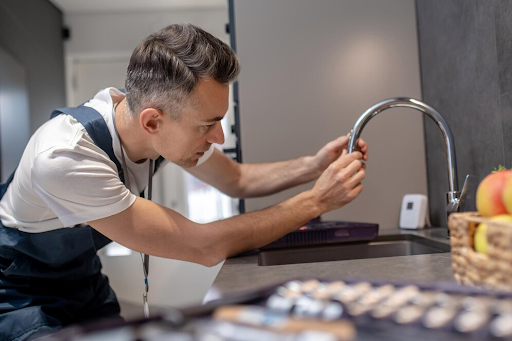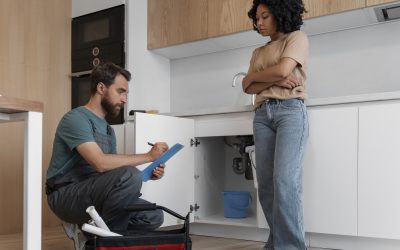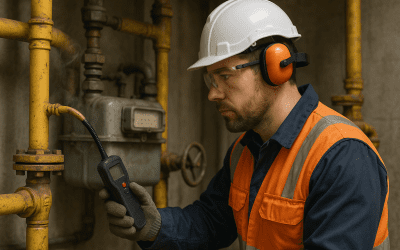So, how do you know when it’s time for kitchen faucet replacement or repair rather than letting the problem linger? In this guide, we’ll highlight the most common warning signs that your faucet needs attention, along with the causes behind them.
5 Signs When to Repair Kitchen Faucets
Persistent Dripping
A dripping faucet is one of the most obvious and annoying problems a homeowner can face. The constant “plink” sound wears on your nerves and also leads to water waste.
In fact, the Environmental Protection Agency (EPA) estimates that a single leaky faucet dripping at one drop per second can waste over 3,000 gallons of water per year. That’s enough to take more than 180 showers!
Persistent dripping is usually caused by:
- A worn-out washer or O-ring
- A damaged valve seat
- Corroded internal parts
- Faulty installation
Over time, these parts deteriorate due to repeated use, exposure to hard water minerals, or age. While you might be tempted to ignore the problem or delay repairs, a dripping faucet can signal deeper plumbing issues and add to your utility bill every month.
Low Water Pressure
Another key sign your kitchen faucet needs attention is a noticeable drop in water pressure. If it takes longer than usual to rinse dishes, fill pots, or wash vegetables, something isn’t right. Low water pressure may be caused by:
- Clogged aerators (tiny screens at the end of the faucet spout)
- Sediment or mineral buildup in the lines
- Faulty cartridges or valves
Rust, Discoloration, or Corrosion
Rust, greenish-blue discoloration, or chalky white buildup around the base of your faucet or on its handles is never a good sign. Once corrosion begins, it can spread quickly and compromise the faucet’s internal parts, making it difficult or impossible to operate smoothly, leading to the need for a kitchen faucet replacement. These signs are typically caused by:
- Hard water (high mineral content)
- Moisture accumulation
- Old, degraded metals
- Improper cleaning or lack of maintenance
Unusual Sounds: Squeaking, Screeching, or Clanking
Is your faucet making strange noises when you turn it on or off? Any kind of squeaking, screeching, or clanking should be investigated. While these noises might not interrupt your day right away, they often signal deeper mechanical or pressure-related problems. Start by checking the washers and aerators. If that doesn’t solve the issue, you may need to install water hammer arrestors or have our plumber in Schertz or Cibolo check for pressure irregularities. Common causes of faucet noises include:
- Air trapped in the pipes
- Loose or worn washers
- Water hammer (sudden pressure changes)
- High water pressure
Water Temperature Fluctuations
If the water from your kitchen faucet goes from hot to cold or vice versa without warning, it could be a sign that something isn’t functioning correctly within the faucet mechanism. Inconsistent water temperature can stem from:
- A faulty mixing valve inside the faucet
- Malfunctioning hot or cold supply lines
- An issue with the cartridge or internal parts
For persistent issues, especially involving hot water delivery, it’s best to have a plumber assess the situation to rule out pipe or water heater problems.
5 Signs When to Replace Kitchen Faucets
In cases where repair isn’t working and your faucet is becoming a hassle more than a help, it’s probably time for a kitchen faucet replacement. Here are a few signs that indicate it’s time to retire your old faucets and replace them.
Persistent Leaks That Just Won’t Quit
If you’ve tightened, re-sealed, or replaced washers, but your faucet still drips or leaks, especially from the base or spout, it’s waving the white flag. Ongoing leaks often point to internal corrosion or worn-out valve seats that no amount of quick fixes can fully cure. And even if you can patch it temporarily, you’re just kicking the can down the road, wasting water and money. It’s probably time to get your kitchen faucet replaced.
Wobbly, Loose, or Outdated Faucet
A wobbly kitchen faucet isn’t just annoying—it can point to deeper issues like a cracked faucet body or a worn-out sink deck. While loose hardware can sometimes be tightened, ongoing instability risks leaks under the sink, leading to water damage. Also, if your faucet is 15–20 years old, it likely lacks modern water-saving features and may not meet current plumbing standards. Older faucets are also harder to upgrade with touchless or low-flow tech. In cases like this, knowing how to replace a kitchen faucet with a modern, efficient model is more cost-effective than continuing repairs.
Low Water Pressure That Isn’t Fixable
Have you cleaned the aerator, checked the supply lines, and your other faucets have normal pressure, but your kitchen faucet still trickles? That’s a red flag. Internal blockages caused by hard water or corroded valves can severely restrict flow. In older faucets, these parts often aren’t designed to be taken apart or cleaned thoroughly. Replacing the whole unit is often the only way to get that strong, steady stream back.
Handle Issues: Stiff, Stuck, or Spinning Freely
In case your faucet handle is tough to turn, constantly sticks, or spins without control, the internal cartridge or valve is likely worn out—or worse, warped. You might try swapping out the cartridge, but if the housing it sits in is damaged or corroded, no new part will work properly. Handle mechanisms should feel smooth and responsive. If they don’t and you’ve tried repairs, it’s faucet retirement time.
Your Faucet Doesn’t Match Your Kitchen Setup Anymore
Okay, this isn’t a “broken” issue, but it’s still a valid reason to replace. If you’ve remodeled your kitchen or changed your sink and your faucet looks or feels out of place (wrong height, awkward reach, bad finish mismatch), that’s a usability and aesthetic problem. An outdated or poorly positioned kitchen faucet can make daily tasks annoying, especially if it doesn’t reach the middle of a new sink basin or gets in the way of cabinetry. Upgrading can improve both the look and function of your space.
Conclusion
Knowing when to repair or replace your kitchen faucet can save you time, money, and a lot of hassle. Don’t wait until a minor drip turns into major damage! For reliable, honest advice and expert service, trust Local Plumbing LLC. Our licensed plumbers in Cibolo and Schertz are just a call away, ready to keep your kitchen running smoothly. Call today at (210) 803-0662 and let us handle the hard work!




